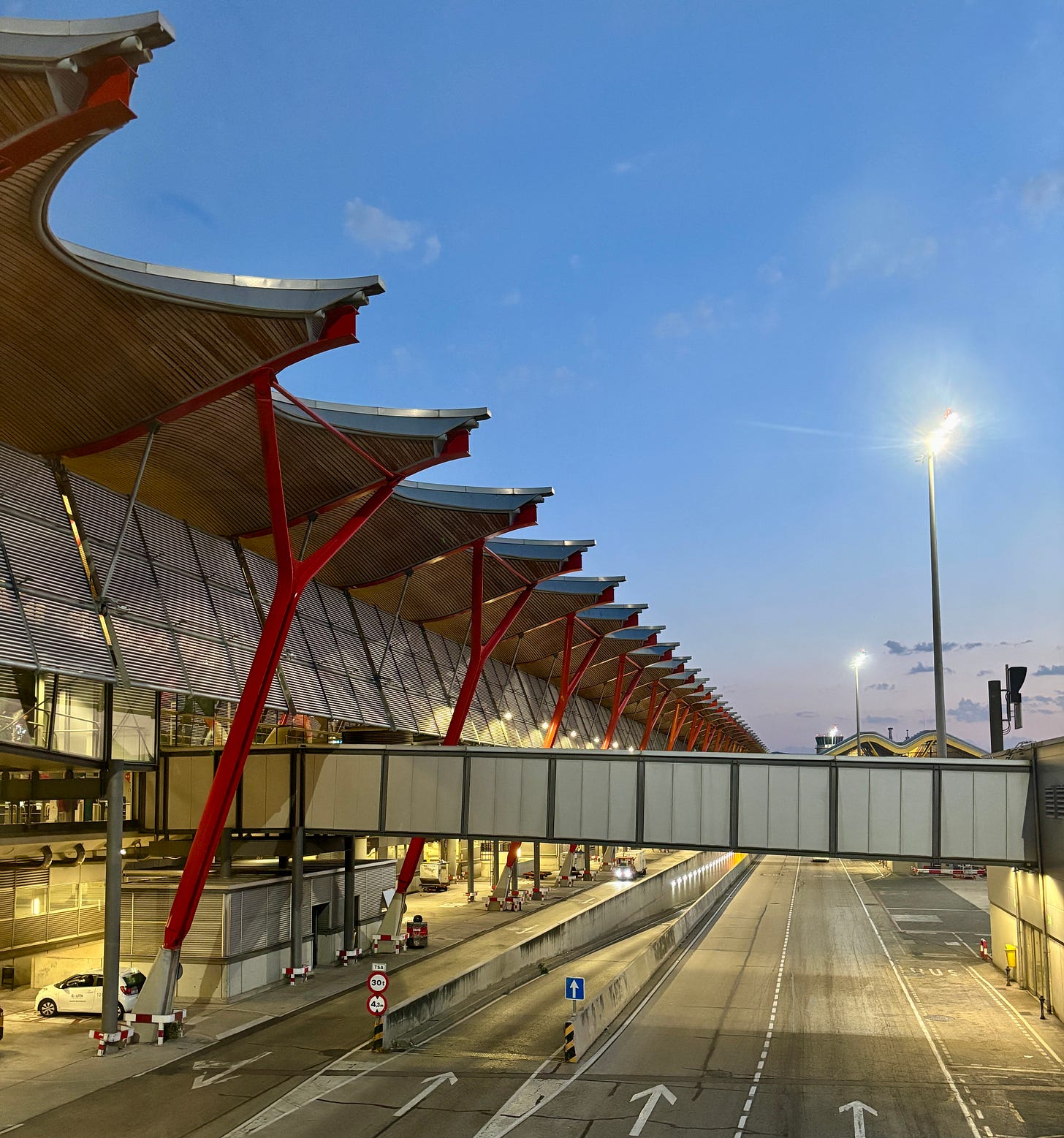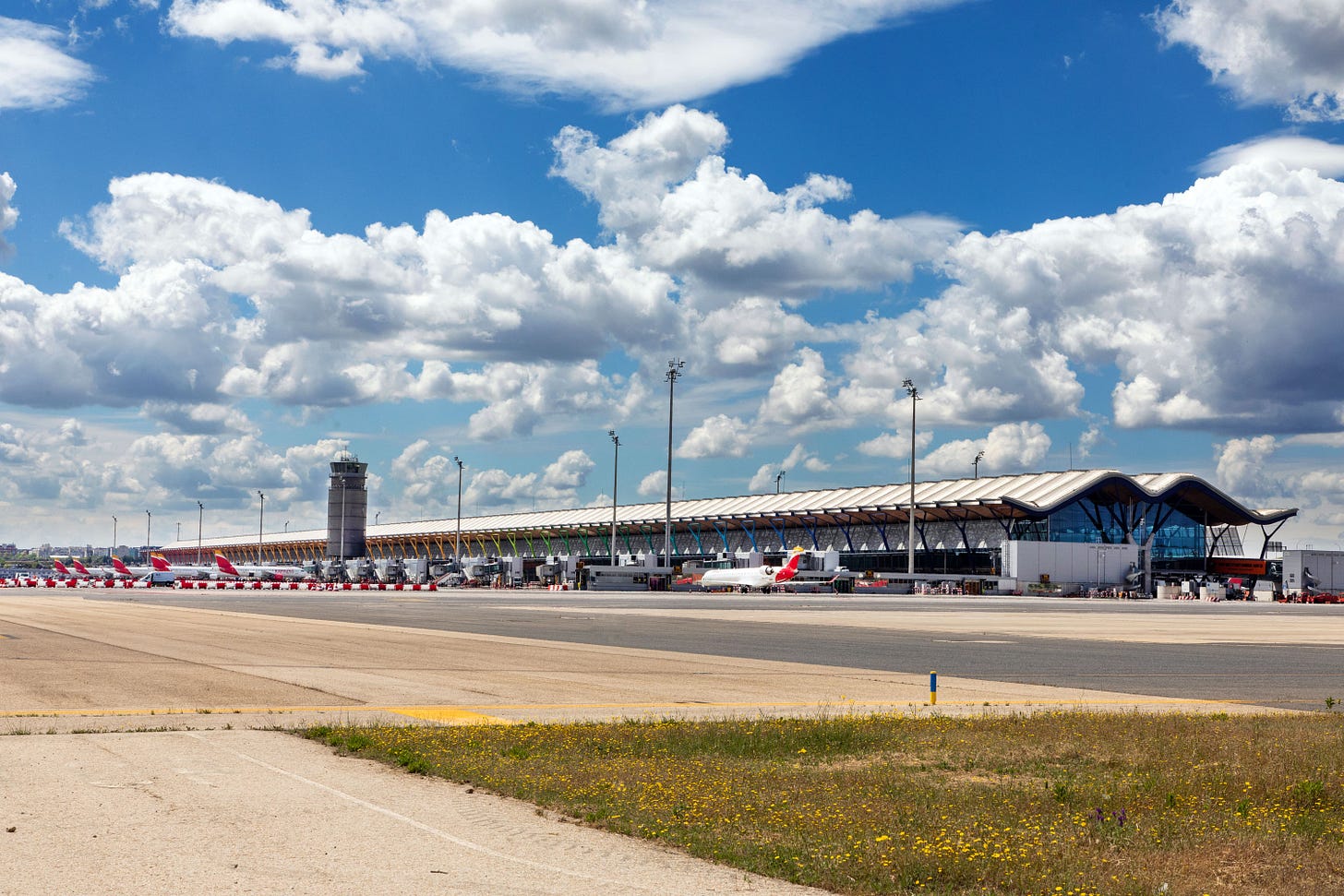The Spanish government made a momentous decision several decades ago. They envisioned Madrid-Barajas Airport as a major European hub in league with Amsterdam and Frankfurt, and needed a terminal up to the task.
The result was Terminal 4, or T4. Opened in 2006, the colorful, light-filled terminal and satellite complex by Richard Rogers and Estudio Lamela today is home to Iberia’s (growing) hub. It’s a coherent answer to the mishmash of styles that is Paris Charles de Gaulle or the the endless, low-ceilinged corridors of Frankfurt.
Or as architecture critic Anatxu Zabalbeascoa put it in Spanish daily El Pais in 2013: “Terminal 4 is a lesson in thoughtful and sustainable design, and at the same time, a bridge to Latin America that allows you to enjoy architecture from the very beginning of many trips.”
All of this is to say that when I received the opportunity to travel through Barajas, I jumped on it. And T4, mostly, did not disappoint.
The first thing a traveler sees upon arriving by plane to T4 is the undulating, aluminum roof with a sawtooth-like canopy reaching out towards over the jetbridges towards the plane. It’s a striking sight, especially when compared to most airport facades: flat walls with, hopefully, windows.
Adding to the excitement of that view are the “gaily painted,” as Architectural Record put it in 2005, support trusses in a variegated gradation from blue in the north to red in the south. Yellow, Zabalbeascoa noted in a 2005 review, is reserved for the central arrivals and departures nodes.
Apparently, the variegated trusses were not part of Rogers and Lamela’s original plan for T4. Their indecision on color “led them to experiment with a chromatic gradation using the colors of the rainbow,” wrote Zabalbeascoa.
Enter the concourse and the scale can overwhelm. The trusses march on seemingly ad infinitum under the rolling, “wave-shaped” roof, as RSHP (formerly Rogers Stirk Harbour + Partners) calls them, punctuated by regular skylights. But of course it is not infinite and, in my opinion, a good lesson in the contemporary airport design best practices of place and transparency.
The many, many skylights harness one thing Madrid has in droves: sunlight. They simultaneously light the space naturally, and soften its dauntingness to travelers.
“The gentleness of the lighting makes a walk through this nominally daunting building a far more relaxed experience than it might otherwise have been. As does the use of color,” The Guardian’s former architecture and design critic Jonathan Glancey wrote in 2006.
Then there is transparency. Modern airports, from London Heathrow to New York LaGuardia, strive to achieve this (some fail miserably) with Barajas an prime example of how to do it well. Save security and passport control that, for good reason, are not open, travelers can almost always see the journey ahead thanks to the copious use of glass and windows throughout the structure.
“The most important thing an airport can do for its users is to be clear and reduce traveler stress,” Carlos Lamela, the head of Estudio Lamela, told El Pais in 2005. “At the new Barajas Airport, travelers can see at all times where they're coming from and where they're going.”
Barajas T4 feels like a page out of Norman Foster’s Stansted Airport pavilion notebook but with a well-executed Spanish flourish.

This is not to say Barajas T4 is without its failings. It is large and, despite the architects’ use of color and distinct areas to break up the monotony, the distances are vast.
The Times of London described Barajas T4’s size as a “cause of frustration” in 2007. And the numerous travelers I spoke too echoed that sentiment.
Case in point: Post-security signage advises travelers to budget at least 20 minutes when heading to a gate in the T4 Satellite where all non-Schengen, or European, flights depart. That does not include the wait at passport control, which was an hour-plus with queues stretching down to the automated people mover platform on my recent trip (this is not so much a design issue as a staffing one).
And the transparency Lamela described fails in one key area: duty free. The moments after I emerged from security and passport control into these warrens of shopping were the only time in my journey through T4 when I was unclear on the journey ahead.
Still, even The Times admitted that: “T4 is probably the world's best-looking airport terminal.”
Does T4 befit a major air hub as the Spanish government envisioned? Absolutely.
T4 is, architecturally, what large hub airports should aspire to be in terms of aesthetics and coherence. It combines local flavor with a well-planned hub complex, much like Munich Airport Terminal 2 but Spanish.
Many airports build signature terminals with grand moments that legitimately impress travelers. Then, as fliers move through their journey from check-in kiosk to airplane, concourses and eventually gates become much more utilitarian affairs.
That is not the case in T4 where the design is almost more impressive post-security. It is in the concourses where travelers will find the light-filled canyons and variegated trusses that enliven the space.
What comes next will put T4 to the test. Barajas operator Aena plans a multi-billion euro expansion designed by Luis Vidal + Architects by 2030 to accommodate the planned growth of Iberia and its partner airlines. The aim is to turn Madrid into something of a Miami International Airport of Europe, the main gateway for travelers from the Americas — particularly Latin America — to the continent.
Iberia’s plan would mean a lot more connecting, non-European travelers through T4. Passport control for those travelers is, in my experience, the facility’s main bottleneck and what could prove an achilles heel to the airline’s — and airport’s — growth ambitions.









It has certainly aged quite well! I didn’t realize it was that old—and, as you mentioned, it’s a stark contrast from Miami’s D concourse, even though the latter was built seven years later.